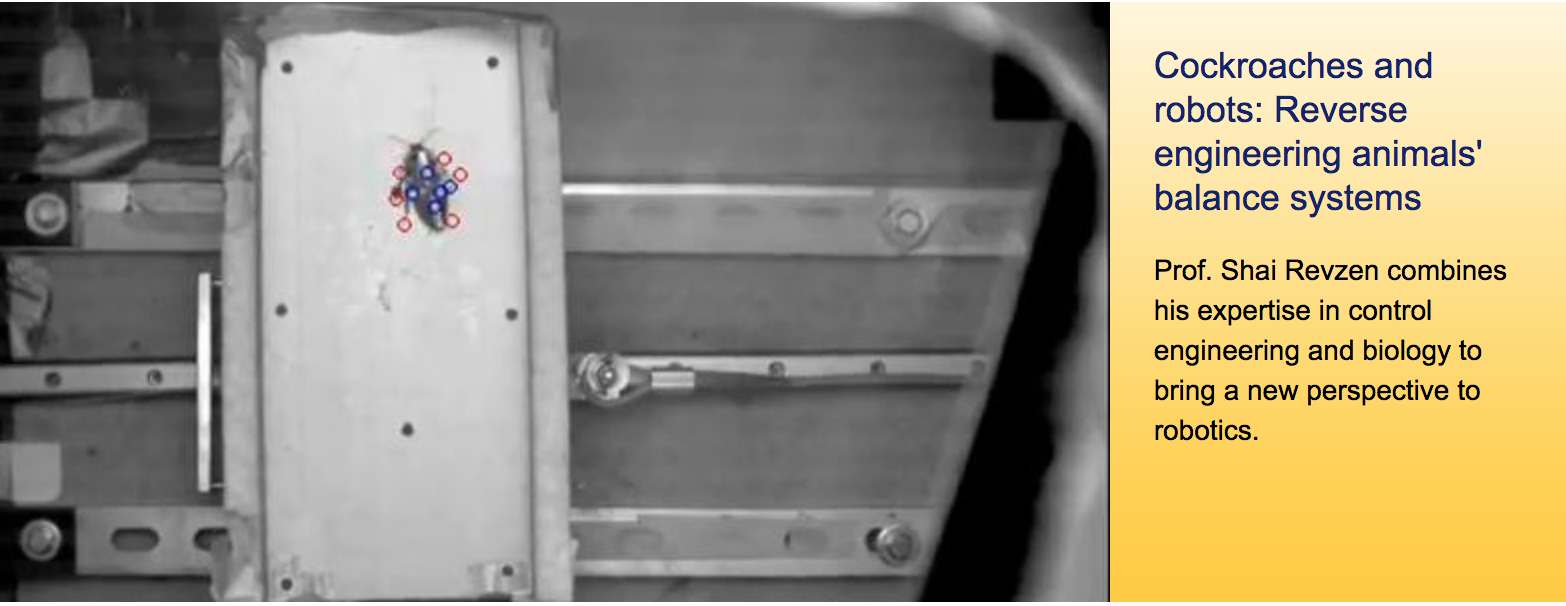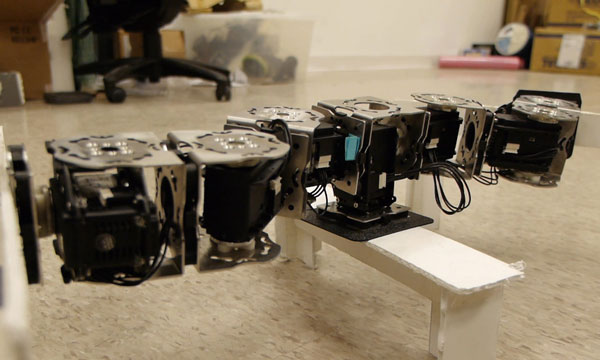Cockroaches and Robots: Reverse engineering the balance systems of animals
These new insights could one day help engineers design steadier robots and improve doctors’ understanding of human gait abnormalities.

 Enlarge
Enlarge
Running cockroaches start to recover from being shoved sideways before their dawdling nervous system kicks in to tell their legs what to do, researchers have found. These new insights on how biological systems stabilize could one day help engineers design steadier robots and improve doctors’ understanding of human gait abnormalities.
In experiments, the roaches were able to maintain their footing mechanically – using their momentum and the spring-like architecture of their legs, rather than neurologically, relying on impulses sent from their central nervous system to their muscles.

 Enlarge
Enlarge
“The response time we observed is more than three times longer than you’d expect,” said Shai Revzen, an assistant professor of electrical engineering and computer science, as well as ecology and evolutionary biology at the University of Michigan. Revzen is the lead author of a paper on the findings published online in Biological Cybernetics. It will appear in a forthcoming print edition.
“What we see,” Revzen added, “is that the animals’ nervous system is working at a substantial delay. It could potentially act a lot sooner, within about a thirtieth of a second, but instead, it kicks in after about a step and a half or two steps – about a tenth of a second. For some reason, the nervous system is waiting and seeing how it shapes out.”
To arrive at their findings, the researchers sent 15 cockroaches (one-by-one, in 41 trials) running across a small bridge onto a placemat-sized cart on wheels. The cart was attached to an elastic cord that was pulled tight like a loaded slingshot and held in place with a strong magnet on the other side. Once a roach was about a body length onto the cart, the researchers released the magnet, sending the cart hurling sideways. The force was equivalent to a sumo wrestler hitting a jogging Revzen with a flying tackle, the professor said, adding that cockroaches are much more stable than humans.
To gather detailed information about the insects’ gait, the researchers utilized a technique Revzen developed several years ago called kinematic phase analysis. It involves using a high-speed camera to constantly measure the position of each of the animals’ six feet as well as the ends of its body. A computer program then merges the continuous data from all these points into an accurate estimate of where the animals is in its gait cycle at all times. The approach gives scientists a more detailed picture than just measuring the timing of footfalls – a common metric used today to study gait. In kinematic phase analysis, the signals are converted into a wave graph that illustrates the animal’s movement pattern. The pattern only changes when the nervous system kicks in. How do the researchers know this? In a separate but similar experiment, they implanted electrodes into the legs of seven cockroaches to measure nerve signals.

 Enlarge
Enlarge
The nervous system delay the researchers observed is substantially longer than scientists expected, Revzen said. And it runs contrary to assumptions in the robotics community, where computers stand in for brains and the machines’ movements are often guided by continuous feedback to that computer from sensors on the robots’ feet. The researchers say the new findings might imply that the biological brain, at least in cockroaches, adjusts the gait only at whole-step intervals rather than at any point in a step. Periodic, rather than continuous, feedback systems might lead to more stable (not to mention energy-efficient) walking robots – whether they travel on two feet or six.
Robot makers often look to nature for inspiration. As animals move through the world, they have to respond to unexpected disturbances like rocky, uneven ground or damaged limbs. Revzen and his team believe that patterns in how they move as they adjust could give away how their machinery and their neurology work together.
“The fundamental question is what can you do with a mechanical suspension versus one that requires electronic feedback,” Revzen said. “The animals obviously have much better mechanical designs than anything we know how to build. But if we could learn how they do it, we might be able to reproduce it.”
More than 70 percent of Earth’s land surface isn’t navigable by wheeled or tracked vehicles, so legged robots could potentially bridge the gap for ground-based operations like search and rescue and defense.
For human gait analysis, the researchers say their non-invasive, high-resolution kinematic phase approach could be valuable in the biomedical community. “Falls are a primary cause for deterioration in the elderly,” Revzen said. “Anything we can do to understand gait pathology and stabilization of gait is very valuable.”
These experiments were conducted at the University of California, Berkeley, before Revzen came to U-M. The work was funded by the National Science Foundation.
Additional Info
Instantaneous kinematic phase reflects neuromechanical response to lateral perturbations of running cockroaches, by Shai Revzen, Samuel Burden, Talia Moore, Jean-Michel Mongeau, and Robert Full, Biological Cybernetic, Advances in Computational Neuroscience, Februrary 1, 2013
In the News
Fox News: Could a roach save your life? Michigan researchers build roach bots (3/11/13)
Popular Science – Watch: How Cockroaches Are Helping Scientists Design Better Robots (February 26, 2013)
Discovery – Cockroaches Teach Robots to Balance (February 26, 2013)
Wired UK – Engineers shoving cockroaches about could lead to more stable robots (Feburary 26, 2013)
TMCnet – Robotics – Cockroaches Could Help Scientists Design More Stable Robots (February 26, 2013)
Science360 – linked to their homepage on February 26, 2013
Homeland Security News Wire – Cockroaches gait informs search-and-rescue robot design (February 25, 2013)
RedOrbit – From Running Roaches to Robots (February 23, 2013)
Neuroscience News – Lessons From Cockroaches Could Inform Robotics (February 22, 2013)
Geek System – Want to Build a Better, More Stable Robot? Look to the Majestic Roach (February 22, 2013)
 MENU
MENU 
